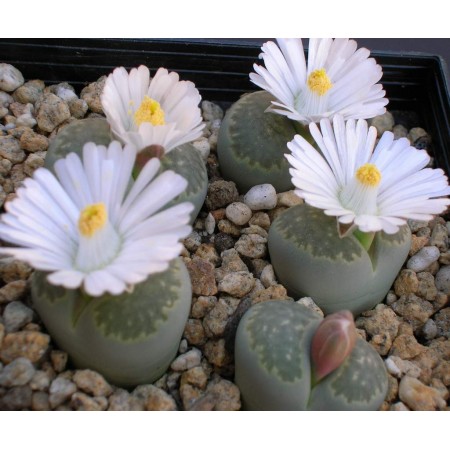Lithops cultivation

At first glance, at lithops, it may seem that they are these little buds growing from ordinary stones. But the lower part of the plant is its integral part, which is why these representatives of the flora got such a catchy name - “living stones”. And in the material presented, we will try to figure out how to grow such an original flower at home.
How to grow
Lithops are very difficult to take root in the new environment, so it is better for them to create, so to speak, a social environment. In other words, it is recommended to grow “living stones” in a group or in combination with other plants - this way they will be able to bloom and “feel” themselves, as if being in a natural environment.
As a pot, it is recommended to choose a not too high capacity (not more than 7 centimeters in height), having previously created a drainage layer at the bottom of a 2-centimeter. The presence of expanded clay or sand is very important, since this flower should not be filled with excess liquid. Mixtures suitable for classical houseplants diluted with a certain amount of coarse sand, small pebbles and pebbles act as a suitable soil for lithops.
Proper watering
The main reason for the rapid death of lithops is the ignorance of gardeners of the rules in the field of introducing liquid into the soil. Mistakes of many can become either an excessive amount of liquid, or its unsuitable composition.
According to the first point, a pot with lithops should be watered only when the earthen lump begins to dry out. The natural habitat of this exotic plant is arid deserts, so it does not require a huge amount of water to survive. It will be enough to moisten the soil once a day in the summer, and do the same procedure no more than once every few days in the winter.
As for the composition of the liquid, then, as in other cases, too hard water can cause irreparable harm to the lithops. Having become ill, this plant has been recovering for a very long time, and for this we will need to pay maximum attention to it. In order to prevent the occurrence of diseases, you should pre-collect the liquid in a container and leave it to settle for 24 hours. It is also allowed to pass water through the filters and warm to room temperature - this action will be optimal in any conditions, and the leafops will be able to delight you with their unique appearance for a long time.
If you are considering engaging in the propagation of lithops, then you will need to observe some specific conditions: maintain the optimum temperature (from 20 to 24 degrees), carefully separate the small shoots from the main plant, select the optimal soil composition, and so on.